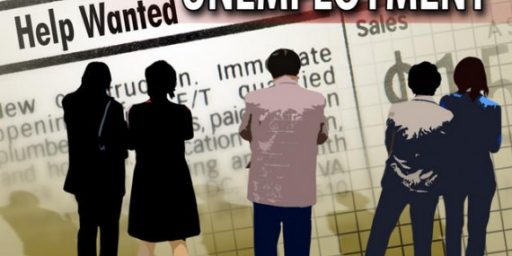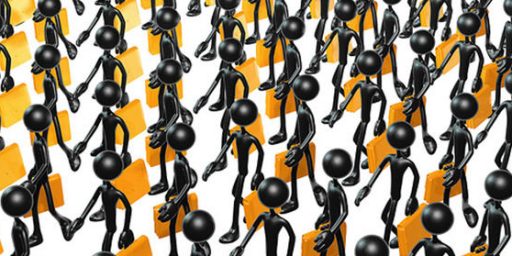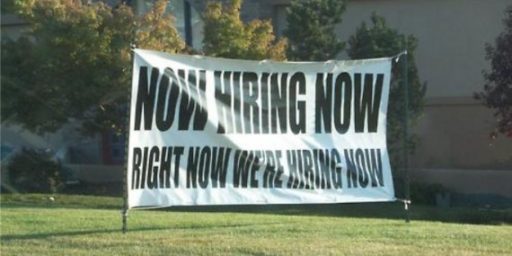New Jobless Claims and PPI Surge
People filing for unemployment insurance for the first time surged to 473,000 compared to the expectations of 430,000. On top of that the Producer Price Index (PPI) rose 1.4% which is considerable faster than the 0.4% that was expected.
The jobless claims numbers underscores the weakness in the jobs market. Unemployment/employment typically are lagging indicators but for the two previous recessions they have lagged considerably behind the recoveries and the length of the lag has grown. Granted we have only two recessions on which to compare, but if the trend continues it could be quite sometime before improvement is seen in the labor market. Hopefully, this wont be the case. The one bit of good news is that the continuing jobless claims is essentially unchanged and has been holding below the 5 million mark.
The increase in the PPI is itself potentially bad news because it could indicate that inflation might be returning and that would mean the Federal Reserve has to make a decision on what to do about it. Of course, most of the increase is due to the energy component of the index. Stripping out the volatile food and energy components the index increased only a 0.3% last month.





Energy is the overlooked factor in any recovery we might have. Price uncertainty plays into the lack of business and consumer confidence.
It’s hard to think that printing $2 trillion dollars and dumping it on the market won’t cause inflation. I was too young (and in another country) when Carter was busy running up the StagFlation. I dread a repeat.
More precisely it underscores the weakness of B. Hussein and his terrorist, nazi, socialism.
Um, bigfire doesn’t recall Ford trying to whip that inflation before Carter? I’ve also heard that it was Nixon’s Fed which lowered rates to goose the economy for his reelection campaign – leading to that later inflation.
How clueless is Obama’s staff on economics? People aren’t working and it is a real surprise when employment numbers suck. You pump money into the economy like the Weimar Republic and you wonder when inflation will hit. You have to wonder if Obama slept through Econ 101 and 102 or if his econ teachers were true socialists. If you have an adjustable rate mortgage you might want to think about locking in because interest rates are about to go up like they did under “put on a sweater” Carter. mpw
Just to clear this up on the inflationary 70’s.
This all started with LBJ. LBJ wanted to fund the expansion of the Vietnam War and also have the Great Society programs. LBJ could not raise taxes as JFK just had the tax cuts. So LBJ had the fed print the money. Depending on the velocity of money, etc. it takes some 3 years to see inflation. This was called “guns and butter economics.”
Inflation was going up under Nixon and he dealt with it with “wage and price controls.” This failed and inflation roared ahead. Ford had inflation and dealt with it with “WIN buttons” and failed. Carter did not know what to do as inflation roared ahead. In each case, the fed raised interest rates to a minimum trying not to do harm to the economy. Carter in his last year brought in Paul Volcker, and under Reagan, Paul Volker raised the prime interest rate to 21.5%. This killed inflation and for over 20 years we enjoyed a non-inflationary recovery.
I would say Bush 43 did the same as LBJ. Bush wanted his tax cuts, his war, and spent the money. Again a “guns and butter” economics. Hence, deficits and debt. Now if LBJ did this and GWB also did this, then this creates a case of many years of either inflation and/or stagflation, deficits and debt, slow growth, and high interest rates. This is just another reason why unemployment will suffer for a long time.
Here is a website that you can create your own graph. If this url does not come out right, try punching in 1965 to the present time and see what you get. You will see that unemployment continually went up during the 70’s and it went down after Paul Volcker did his job. It also shows how unemployment went down in a non-inflationary time. Now if Bush repeated the “guns and butter” of LBJ, then we can see what our future brings.
http://data.bls.gov/PDQ/servlet/SurveyOutputServlet
http://data.bls.gov/PDQ/graphics/LNS14000000_98832_1266551297800.gif
Add to this that nothing has been done on globalization.
That our jobs went overseas.
That our stores are full of Chinese goods.
That widgets can be made anywhere outside the U.S.
That we are not energy independent and could receive oil shocks.
That we are a nation of failed ideology.
That it will take years to restore the jobs lost.
That we have deficits and debt.
That 2 billion people want our jobs and there is not enough jobs to go around
That it takes years to rebuild a country after a war or depression.
That China continually reaches 8% growth and we will average less than 3%
And we still have two wars which is a drain of our resources.
And we have not invested in our country, in our people, and in the future.
Here ya go:
http://finance.yahoo.com/news/Fed-bumps-up-rate-banks-pay-apf-4141548450.html?x=0&.v=3
“Stripping out the volatile food and energy components the index increased only a 0.3% last month.”
And this is perfectly reasonable, because people do not have to eat, drive their cars or heat their homes. The food and energy costs were “stripped out” not because they are volatile, but because they were inflating and causing the inflation number to be ugly and alarming. By removing them, the government could publish a number that would not make the government look bad, not alarm people, and not make the voters pissed off at the governemnt.
Same thing with unemployment. If we published unemployment the same way they did in 1930, unemployment today would be 17.5% and we would be in a depression. By “stripping out” those who have given up looking for work and other manipulations, we can report 9.7% and call it a recession.